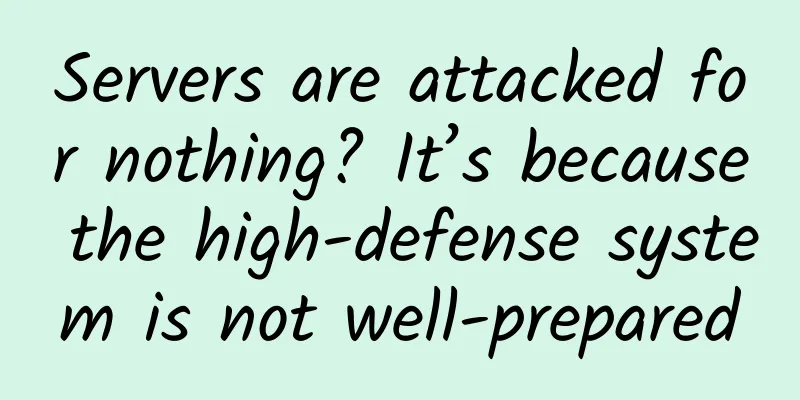Servers are attacked for nothing? It’s because the high-defense system is not well-prepared

|
The development of cloud servers is unstoppable. With the new generation of delivery and usage model of IT infrastructure resources, cloud servers have occupied a place in the market. The era of "enterprises moving to the cloud" has begun, and network security has become a key focus. With the frequent occurrence of CC/DDoS attacks, ordinary servers without defense functions have gradually declined, while high-defense servers have begun to rise. High-defense servers are servers that can help websites prevent denial of service attacks and regularly scan existing network main nodes to find possible security vulnerabilities. High-defense servers mainly refer to independent single hard defense servers with a capacity of more than 50G, which can provide security maintenance for a single customer. Generally speaking, they are a type of server. Depending on the environment of each IDC computer room, some provide hard defense and some use soft defense.
There are a lot of cloud server providers on the market. Of course, Alibaba Cloud and Tencent Cloud, which provide services for large enterprises, are safe and reliable. For example, Panshi Cloud, which provides services for small and medium-sized customers, can also be equipped with high-defense packages to upgrade servers in all directions to resist malicious attacks. However, some businesses are selling ordinary servers under the banner of "high-defense". These cases are not uncommon. So, how can we accurately identify whether a cloud server is really high-defense? Data storage High Defense: Deployed in a cloud resource pool built with a large number of server clusters, it is a network-based distributed data storage with no single point of failure. Normal: All data is stored in the local hard disk of a single server, and distributed deployment cannot be achieved. Therefore, there is always the risk of machine hardware failure. Once a hardware failure occurs, it cannot be automatically and quickly recovered. Data backup High Defense: Supports snapshot backup strategy, can write multiple copies of data in real time, even if user data is lost or deleted by mistake, it can be quickly scheduled for backup and recovery online, which is unmatched by traditional backup methods. Normal: It is difficult to provide real-time snapshot backup function. The most common processing method is for the administrator to export the backup data, repair it, and then re-import it. Physical architecture support High Defense: The bottom layer is composed of large-scale server clusters, forming a massive computing, storage, and network resource pool in the cloud. Resources are allocated according to user demand, thus achieving efficient utilization of resources. Normal: Services are provided by an independent physical server, and hardware failures cannot be automatically repaired. Thermal migration capability High Defense: Supports hot migration. Even if the hardware of an underlying server fails, user services can be migrated online to other cloud servers, and the migration process will not affect the normal operation of the website. Normal: Once a hardware failure such as hard drive damage occurs, you can only manually transfer the data backup to other cloud servers to resume work, and only after you complete the migration work can your website resume normal access. Fault recovery speed High Defense: Supports fast reconstruction of different nodes, which means that even if the computing node is abnormally interrupted or damaged, the virtual machine can be rebuilt through other different nodes in a very short time without affecting data integrity. Normal: This function cannot be provided. |
>>: Summary of core technologies and solutions for personal area networks
Recommend
The Best Open Source Network Monitoring Tools of 2017
The demand for open source software continues to ...
LMT to build 5G air-ground hybrid network with Omnispace
According to foreign media reports, Lockheed Mart...
How to choose NB-IoT, Cat.1, and Cat.M for IoT device communication?
1. What is NB-IoT NB-IoT (Narrow Band Internet of...
Wangsu Security: To prevent the “barrel effect” in network security, how can enterprises build “systematic security”?
Recently, a technical exchange meeting on Wangsu ...
How to build your private LTE network
Private LTE networks are becoming increasingly po...
5G services market expected to exceed $919.4 billion by 2031
According to a recent report by Transparency Mark...
Six common IoT wireless technologies and their use cases
The Internet of Things (IoT) starts with network ...
After three years of cooperation, Huawei and Beijing Ruicheng Times have created a new name card for smart cities
[51CTO.com original article] As soon as I walked ...
Relax and have fun during the Dragon Boat Festival. WiFi signal must be strong. Here's how to adjust it
During the Dragon Boat Festival holiday, there ar...
Five-year action plan for new infrastructure in the transportation sector released
As one of the main driving forces of urban develo...
DediPath Spring Promotion: 35% off on all VPS, dedicated servers starting at $49/month, Los Angeles/Dallas/Seattle/New York data centers
DediPath has just launched a spring promotion, of...
Now is the time to use 5G indoors
Operators have made huge investments in 5G RAN, w...
Network Slicing "Hot Pot Theory": Same Pot, Different Dreams
In the dog days of summer, when people are "...
How do terminals in a LAN access the external network? The answer is at the end
[[357957]] 0. Fans Questions Fans asked: "Ho...









